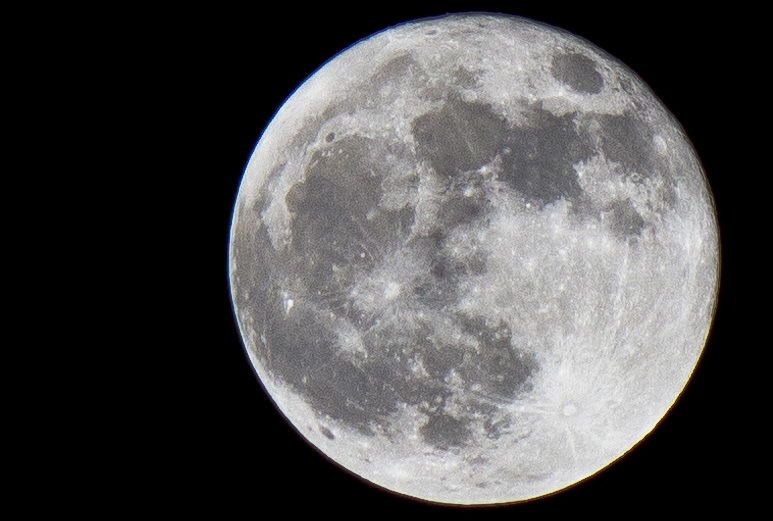Moon, Planet and Star Meet in Night Sky This Weekend

On three consecutive mornings, starting Sunday (Dec. 9), the moon will perform a bit of "celestial hopscotch" and pass near three bright celestial bodies: a bright star and two planets. Here we'll talk briefly about the first two encounters early on Sunday and Monday (Dec. 10) mornings.
Coming up above the east-southeast horizon around 2:45 a.m. local time on Sunday will be a slender crescent moon. And situated approximately two moon-widths to its lower right will be a bright, bluish star. That will be Spica, brightest star of the constellation Virgo. By 5 or 6 a.m. they will be readily visible, well above the southeast horizon.
Spica is the only conspicuously bright star in Virgo. A bluish-white star of great luminosity, Spica is so far away that its light requires 262 years to travel across the vast gulf of space that separates it from Earth. Since light travels at 186,282 miles per second (299,791 kilometers per second), it is obvious that Spica must be far brighter than our sun, but tremendously farther away. Indeed, it's a brilliant "helium" type star, about 2,300 times more luminous than our sun.
Spica ranks as the 16th brightest star in the night sky and can be regarded as a nearly perfect example of a star of the first magnitude. Magnitude is how astronomers measure the apparent brightness of celestial objects. The lower the value, the brighter the object; a star of the first magnitude is 100 times brighter than a fifth magnitude star. [December 2012 Night Sky Maps]
The name Spica comes from the Latin "Spicum," and is said to signify a spike or ear of wheat. It is derived from the ancient allegorical drawings of the goddess whose figure was somehow or other traced around the scattered stars by the imaginations of primitive stargazers.
In many parts of the classical world she is the "Wheat-Bearing Maiden" or the "Daughter of the Harvest." The goddess was shown holding several spears of wheat in each hand, and Spica is in one of the ears of grain hanging from her left hand, evidently representing the harvest time that occurred when the sun was passing this bright star. Interestingly, in another legend, Virgo supposedly represented Persephone, daughter of the goddess of the harvest, Ceres, and as such is associated with agricultural matters.
On Monday morning, the moon will have moved farther down to the lower left of Spica. It will have also thinned noticeably since Sunday morning, being 21 percent illuminated on Sunday compared to just 12 percent on Monday. And shining with steady, sedate yellow glow well above and to the moon's left will be the most impressive planet in our sky: Saturn. Both moon and Saturn will be well up in the southeastern sky at dawn.
Sign up for the Live Science daily newsletter now
Get the world’s most fascinating discoveries delivered straight to your inbox.
The "lord of the rings" planet is about a dozen degrees east of bluish Spica (your clenched fist at arm's length measures about 10 degrees) and will appear similar in brightness.
This past Thursday, Saturn crossed over the border of Virgo on into the constellation Libra. Its famous ring system is tipped 18.3 degrees toward Earth — the most "open" view we've had since June 2006 —and provides a spectacular view even in small telescopes that magnify by at least 30-power.
Made up of billions of ice and rock particles of all sizes — from small debris to boulders as big as houses — these rings orbit Saturn at varying speeds. There are hundreds of these rings, believed to be pieces of shattered comets, asteroids or moons that broke apart before they reached the planet. The rings are so big that they would fill most of the distance between Earth and the moon.
Have you ever seen Saturn in the daytime? Here's a perfect chance; just aim a telescope at Saturn while it's still dark and keep track of it relative to the moon as the sky brightens. Shortly after sunup, Saturn will still be dimly visible against the bright blue sky.
Finally on Tuesday morning (Dec. 11), the moon will team with the brightest planet of all, Venus.
This story was provided by SPACE.com, a sister site to Live Science. Joe Rao serves as an instructor and guest lecturer at New York's Hayden Planetarium. He writes about astronomy for The New York Times and other publications, and he is also an on-camera meteorologist for News 12 Westchester, New York. Follow SPACE.com on Twitter @Spacedotcom. We're also on Facebook & Google+.













